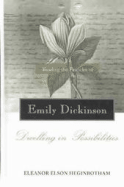Reading the Fascicles of Emily Dickinson: Dwelling in Possibilities

by Eleanor Elson Heginbotham
ISBN: 081420922X
Post Your Opinion | | A Review of: Reading the Fascicles of Emily Dickinson: Dwelling in Possibilities
by Cindy MacKenzieThe persistent fascination of scholars and readers with Emily
Dickinson's preparation of forty fascicles'-those little booklets
of carefully stitched stationery sheets of about half of the over
1700 poems she wrote between 1856 and 1864-is central to an
understanding of the genius of this great nineteenth-century American
poet. In Eleanor Heginbotham's enthusiastic and thorough examination
of the fascicles, the primary focus is on demonstrating the
"intentional artistry" of the poet in compiling these
booklets as a form of self-publishing, and more interestingly, as
a space where she can edit and play with the effects of setting the
poems in such a way that they "echo and speak to each other
across the page," making them "new artifacts by virtue
of their proximity." The book's title, Reading the Fascicles
of Emily Dickinson: Dwelling in Possibilities highlights Heginbotham's
thesis as well as Dickinson's own poetics of "dwelling in
possibility," to resist limitation or closure at all costs.
The study emphasizes the artistic presence of the poet; it allows
us to "sense the poems as hers, as belonging to and issuing
from her specific and particularly personal character and
lifestyle." Whatever else they mean, Heginbotham insists, they
exist and, as such, cannot be discounted completely as many critics
have attempted to do. Instead, she continues, they provide one way,
and a very legitimate way, of considering an individual poem's
meaning within a context that is constructed by the poet herself.
These forty fascicles, holding between 11 and 29 poems, offer a
logical way for us to "see what proximate poems can tell us
about each other and what the selections suggest about the concerns
of their author at the moment that she bound them together."
For it is the "pressures of the surrounding work" that
reveal how a single poem can be read by creating more than one
interpretative possibility within a changing context. The magnitude
of the project forces Heginbotham to focus on four pairs from the
handbound booklets. She is well aware that her work is only beginning
a study that could be continued by other scholars in the future.
Heginbotham's book conscientiously and meticulously acknowledges
those scholars who concentrate on this aspect of Dickinson's work.
As a result, the book offers a bibliographical resource that is
thorough and up-to-date. Her readings of the poems within the
framework Dickinson creates provide new and insightful interpretations
that illustrate the "possibility of meaning" that each
juxtaposition of poems has the capacity to create. While she
consults some theoretical sources, such as Michael Riffaterre's
Semiotics of Poetry and Neil Freistat's Poems in their Place: The
Intertextuality and Order of Poetic Collections to support her own
theory, she also includes her "conversations" with twelve
contemporary poets-Richard Wilbur, Adrienne Rich, and Alicia
Ostriker-to substantiate her ideas about the deliberateness and
importance of placing the poems in a certain order or chronology.
Although unconventional as a modus operandi, the results are
fascinating and most compelling to read because they open up the
entire question of authorial intention in quite a groundbreaking
way.
Heginbotham's book is an important addition to the scholarly canon
as it offers all readers of Dickinson an important new way to
understand the enigmatically dazzling work of this complex American
poet.
|